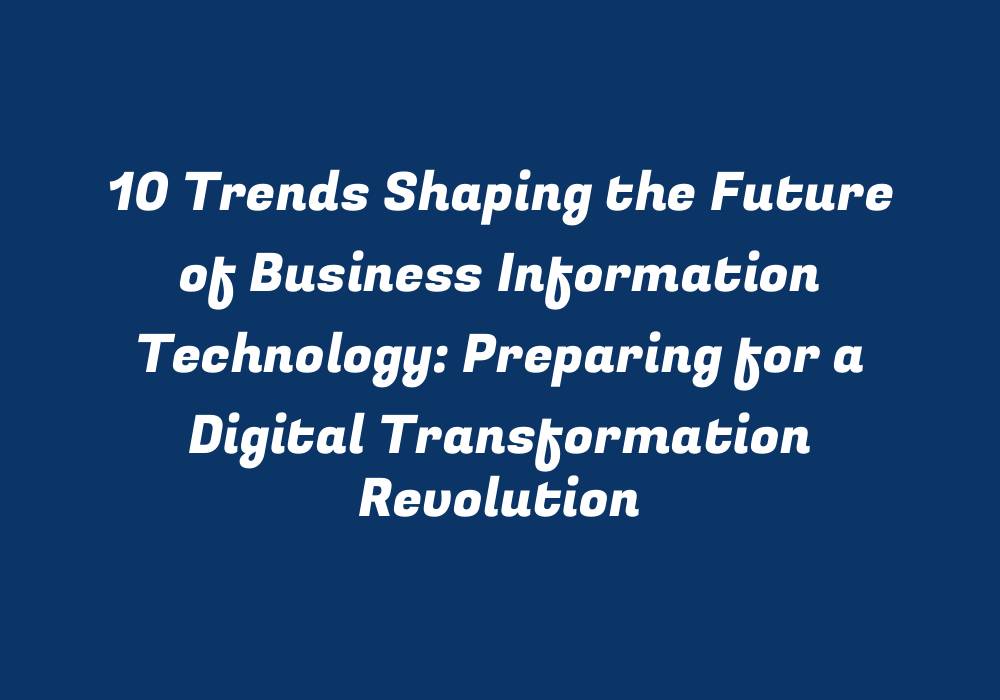Introduction: The Evolution of Business and IT
Business Information Technology (BIT) has evolved significantly over the past few decades, transforming how organizations communicate, collaborate, and make decisions. As we look to the future, it’s essential to understand the trends shaping this space so that businesses can successfully navigate through digital transformation. In this article, we will discuss 10 key trends impacting the evolution of business information technology.
Trend 1: Cloud Computing
Cloud computing has become a vital part of BIT by enabling organizations to store and access data remotely. This trend is empowering businesses to scale up or down their IT infrastructure as per requirement, saving both time and money. The flexibility offered by cloud services also allows for easier collaboration among employees, regardless of their location.
Trend 2: Artificial Intelligence (AI) and Machine Learning
The rapid advancements in AI and machine learning are revolutionizing the business landscape, enabling organizations to make smarter decisions. AI-powered tools can automate repetitive tasks, improve data analysis, and optimize processes for greater efficiency. Businesses that leverage these technologies stand to gain a competitive edge and streamline their operations.
Trend 3: Internet of Things (IoT)
The advent of the Internet of Things connects an unprecedented number of devices, leading to vast amounts of data generation. This trend is enabling organizations to capture valuable insights from real-time information and make better-informed decisions. By integrating IoT into their systems, businesses can enhance customer experiences, improve efficiency, and optimize supply chain management.
Trend 4: Cybersecurity
As the world becomes increasingly interconnected, cyber threats become more sophisticated and widespread. This trend has driven the need for robust cybersecurity measures that protect sensitive data and prevent unauthorized access. Organizations must invest in advanced security solutions to safeguard their digital assets from potential breaches or malicious attacks.
Trend 5: Big Data Analytics
The growth of data generation has led businesses to leverage big data analytics for making more informed decisions. This trend enables organizations to harness valuable insights from large volumes of structured and unstructured data, ultimately improving customer experiences and driving business growth.
Trend 6: Blockchain Technology
Blockchain technology is transforming the way businesses transact and exchange information. By offering a secure and transparent digital ledger system, blockchain ensures increased efficiency in supply chain management, financial transactions, and contracting processes. This trend also fosters trust between stakeholders by minimizing fraud and reducing operational risks.
Trend 7: Mobile Technology
The rapid growth of mobile technology has made it an essential part of business information systems. Mobile apps enable organizations to reach customers directly, improve their engagement, and enhance communication between employees. This trend is also driving the adoption of BYOD (Bring Your Own Device) policies, which can lead to increased productivity and flexibility in the workplace.
Trend 8: Virtual Reality (VR) and Augmented Reality (AR)
Virtual reality and augmented reality are becoming increasingly popular in various industries. They offer new ways for businesses to create immersive experiences, improve training processes, and enhance customer engagement. As these technologies continue to evolve, they will play a significant role in shaping the future of business information technology.
Trend 9: Robotics and Automation
Robotic process automation (RPA) is reshaping the way businesses operate by streamlining manual tasks. This trend allows organizations to focus on more strategic initiatives, reducing errors and increasing operational efficiency. As robotics technology advances, its integration into business processes will continue to drive digital transformation across industries.
Trend 10: Sustainability and Environmental Awareness
As businesses become increasingly conscious of their impact on the environment, the demand for sustainable solutions is growing. This trend emphasizes the importance of implementing eco-friendly IT practices to reduce energy consumption, minimize waste, and promote responsible resource utilization. By embracing green technology, organizations can position themselves as leaders in environmental stewardship.
Conclusion
The future of business information technology is rapidly evolving, driven by various trends that are shaping digital transformation across industries. To stay ahead of the curve, businesses must adopt these innovations and adapt their strategies to accommodate continuous technological advancements. By embracing these trends and investing in the right technologies, organizations can ensure a smooth transition into the digital age while reaping the benefits of enhanced efficiency, improved customer experiences, and sustainable growth.
